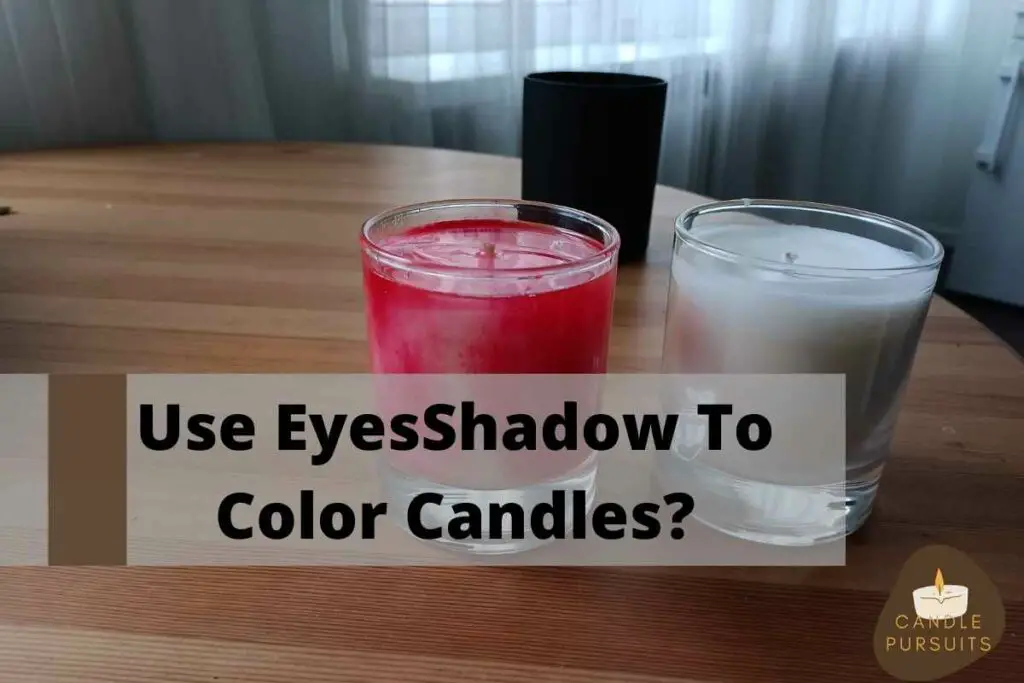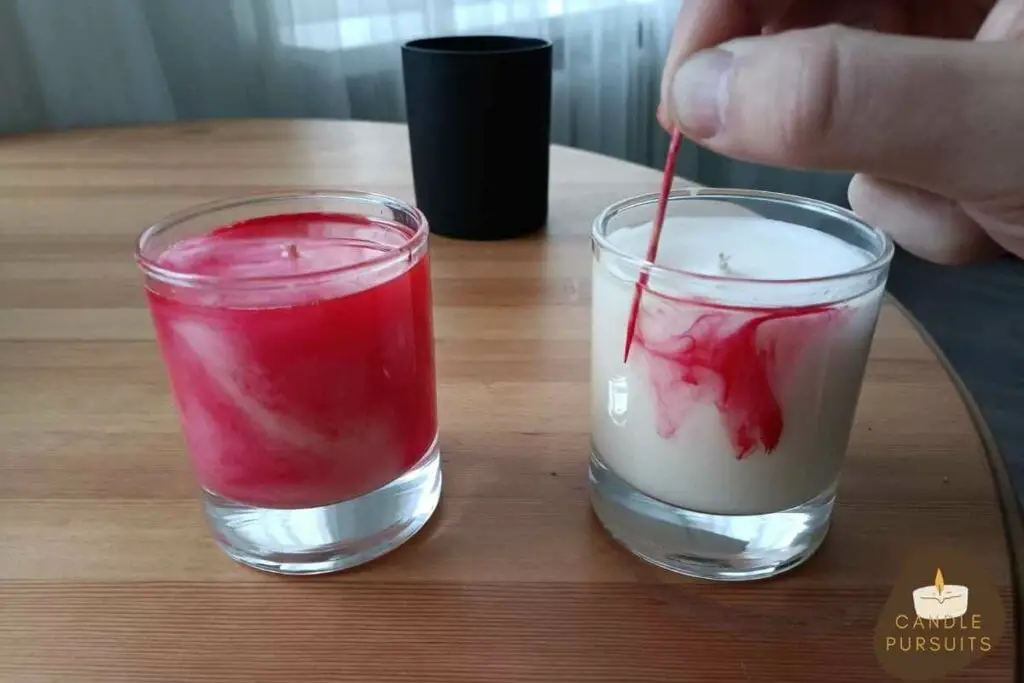If you’re someone who’s into DIY projects, you’ve probably been in that situation where you don’t have all the materials you need. What do you do next? You improvise, of course! When it comes to candle making, many people try to improvise when it comes to coloring their candles. One such improvisation is using eyeshadow instead of candle dye to get the color they want. But is this a good idea?
You should not use eyeshadow when you’re trying to color your candles. Eyeshadows are made of pigments, and pigments do not dissolve in wax. This means that they’ll stay suspended in the candle wax and end up clogging the wick, causing your candle to burn poorly.

However, not all is lost. In this article, we’ll talk about some other ways you can get the colors you want in your candles without using eyeshadow. We’ll also take a look at what ‘not’ to use when coloring candles. So, whether you’re a beginner or an experienced candlemaker, read on for some helpful tips!
What Can You Use Instead of Eyeshadow to Color Candles?
As we’ve mentioned before, eyeshadow is a type of pigment. And pigments are non-soluble in wax. So, what can you use instead to color your candles?
Dyes are colored substances that chemically bind to other substances, rather than just being suspended like pigments. When you use them to color candles, they will dissolve in the wax and give you a more beautiful and consistent color. You’ll also not have to worry about clogging up your wick!
There are many types of dyes that you can use when coloring candles and the type you choose will depend on the look you’re going for. There are dye blocks, liquid dyes, and powder dyes, each with its own benefits and drawbacks.
- Dye Blocks
Dye blocks are the most commonly used type of dye when coloring candles. They come in a variety of colors and are easy to use. All you have to do is shave off some of the blocks with a knife and add it to your melted wax.
The only downside is that you may not be adding the exact amount of block every time, so there might be slight variations in color between batches.
- Liquid Dyes
Liquid dyes are also easy to use and come in a wide variety of colors. They can be added directly to the melted wax or you can make a dye solution by adding some hot water. You can also mix and match different liquid dyes to create unique color combinations, which is not possible with other dyes.
However, they do tend to have a strong odor that might affect the scent of your candles.
- Powder Dyes
Powder dyes are perhaps the strongest and most concentrated of all the dyes. With just half an ounce, you can easily color about 150-200 pounds of wax. Hence, you should be very careful when using them, if you do not want your candles to be extremely saturated with color.

The good news with using powdered dyes – they are less prone to fading and will last a long, long time!
Fun Fact – All dyes, whether it’s liquid or block, start out in the form of powder dyes. When solvents are added to the dye, it becomes liquid dye, and when paraffin/stearic acids are added, they become dye blocks.
What Not to Use When Coloring Candles
Now that we know what to use when coloring candles, let’s take a look at some of the things you should avoid (Eyeshadow being one!). This is especially important for beginners who might not be aware of the dangers of using certain ingredients.
1) Crayons
Crayons are a big no-no when it comes to coloring candles. Yes, they are made of wax, but they also contain pigments and other additives which is what gives the crayon its color.
Once the crayon melts, all these pigments and additives get suspended in the wax, eventually getting sucked into the wick and clogging it up from the inside.
This will cause your candle to burn very slowly or not at all. So, save the crayons for coloring in your kids’ coloring books and use something else when coloring candles.
2) Food Coloring
Food coloring is in liquid form, so it should dissolve properly in wax, right? Wrong! Food coloring is water-based, and as you know, water does not dissolve in wax. When you add liquid food coloring to wax, it will clump up and eventually sink to the bottom of your container.
Not only will this make your candle look unattractive, but it will also prevent the candle from burning properly.
3) Titanium Dioxide
Titanium dioxide is a white substance that is popularly used to dye things pure white – this includes paint, paper, ink, and toothpaste. So naturally, when people want their candles to be stark white in color, they might try and use titanium dioxide. Unfortunately, this is not a good idea.
As a coloring agent, titanium dioxide is mostly available in pigment form. This means that once it is added to the wax, it will prevent it from burning properly. Most white dyes available on the market also use titanium dioxide as their main ingredient, so it’s best to avoid using it altogether.
Note – Coloring a candle white is quite difficult and not recommended at all. The only way to get white candles is to use white waxes such as paraffin or palm. You can use soy wax as well if you’re looking for an off-white, creamy color.
Difference Between Pigments and Dyes
We’ve used the terms pigments and dyes quite a few times in this post, so let’s take a minute to clarify the difference between the two. Take a look at the table below.
| Pigments | Dyes |
| Usually inorganic colored compounds | Usually organic colored compounds |
| Very large particle size | Extremely tiny |
| Insoluble in water and most solvents | Soluble in water |
| Diffuses on the fabric | Diffuses within the fabric |
| High Lightfastness – This means that they’re resistant to fading. | Low Lightfastness – Will fade over time. |
| Opaque | Transparent |
| Cheap | Expensive |
As you can see, pigments and dyes are as different as night and day. They both have their own unique properties and are used for different purposes. But when it comes to coloring candles, always remember – dye is the way to go!
FAQs
Let’s take a look at some of the most common questions with regards to coloring candles.
Q1) What are some natural methods to color my candles?
A. There are various natural ingredients you can use to color your candles. Here are some of them – Spirulina (sea green), peppermint (light green), Madder root (peach), Annatto (yellow), and Alkanet (burgundy red).
Q2) Which is the best dye for wax candles?
A. You can use dye blocks if you’re looking for darker, richer colors that are more opaque. If you’re looking for lighter colors or want to achieve a pastel effect, dye chips are the way to go.
Q3) Can I use glitter while making candles?
A. No, do not use glitter when you’re making candles. While wax will only melt in high heat, glitter can catch fire and cause a serious accident. Avoid it at all costs.
Final Thoughts
Candle making is an amazing hobby that you can pick up quite easily and spend hours on, but it’s important to take the necessary precautions when using certain ingredients.
So, next time you’re looking to color your candles, remember to stick with dyes and avoid pigments and other coloring agents that might not be safe for use. Let your eyeshadow and other makeup products stay where they belong – on your face!
